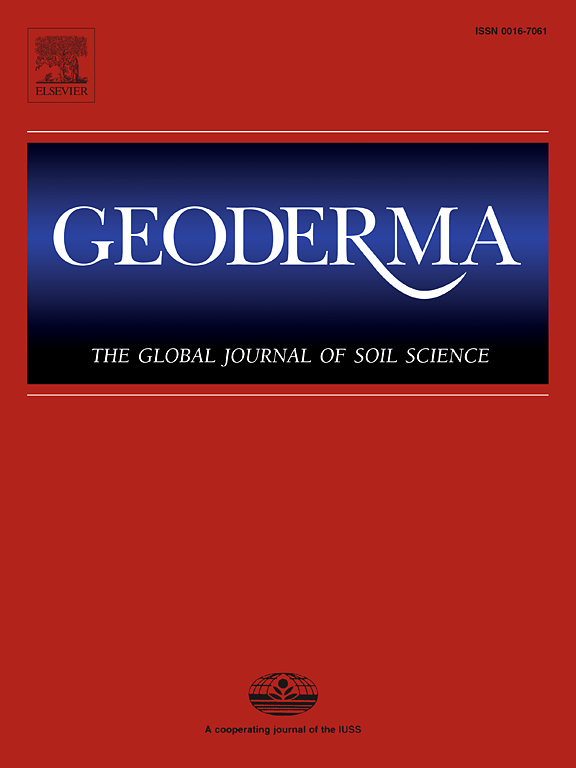SOC:粘土比:跨生态区和土地利用类别的、机械上合理的、通用的土壤健康指标?
IF 5.6
1区 农林科学
Q1 SOIL SCIENCE
引用次数: 0
摘要
欧盟最近提出了一项关于土壤监测和恢复力指令("土壤监测法",SML)的提案,将 SOC:粘土比率定义为土壤有机碳(SOC)状况的描述指标,1/13 的比率将 "健康 "和 "不健康 "土壤区分开来。本文利用下奥地利土壤数据库的数据,探讨了 SOC:粘土比率在生态多样性研究地区的机理基础和适用性。我们观察到不同农业生态区域的 SOC:粘土比率存在很大差异,因为粘土含量和 SOC 受不同生态变量的驱动,其中粘土含量与母质的质地有关。根据土地利用(耕地与草地)进行分层后,我们建立了多元回归模型,从一组初始预测变量开始,包括年平均降水量(MAP)和温度(MAT)、粘土含量、CaCO3 当量、Al 的无定形氧氢氧化物(Alo)和 Fe 的无定形氧氢氧化物(Feo)以及 pH 值,以确定 SOC 的主要驱动因素及其相对重要性。最终模型解释了 23% 到 77% 的 SOC 总体变化,并揭示出在整个研究区域和大多数农业生态和土壤单元中,SOC 主要受 Alo 和 CaCO3 当量控制,粘土含量和 MAP 的影响较小。相关的 SOC 驱动因素及其相对重要性随空间尺度(整个研究区域与农业生态和土壤单元)、干旱指数(定义为 MAT:MAP)以及土壤 pH 值反映的土壤发育状况的不同而变化。除了一些明显的例外,Alo 在湿度较高的地区和酸性土壤中最为重要,而 CaCO3 当量和粘土含量的相关性则随着 pH 值和干旱度的增加而增加。此外,我们也无法证实 SOC:粘土比率与通过目测评估得出的土壤结构质量之间存在有意义的函数关系。这些发现对普遍使用 SOC:粘土比作为土壤健康的描述指标,以及其 1/13 的临界值来区分不同生态区域的土壤健康状况提出了挑战。如果 SOC 并非主要由粘土含量驱动,那么按照 SML 的建议对 SOC:粘土阈值使用校正因子也是不合适的。为了得出有意义的 SOC 区域基准,我们建议采用多元回归分析法,将 SOC 的主要驱动因素作为输入变量。回归方程可用于预测在相关主要土壤和气候驱动因素的任何给定值下,该地区平均管理制度下的 SOC 水平。这种方法还可以进一步细化,具体方法包括:缩小到土壤单位水平,为不同的、定义明确的土壤管理类别建立关系,并将其与土壤功能特性(如空气容量、结构质量分数)进行校准,以便将基准与土壤管理、土壤健康及相关生态系统服务联系起来。本文章由计算机程序翻译,如有差异,请以英文原文为准。
SOC: clay ratio: A mechanistically-sound, universal soil health indicator across ecological zones and land use categories?
The European Union has recently launched a proposal for a soil monitoring and resilience directive (“soil monitoring law”, SML), defining the SOC: clay ratio as descriptor of the soil organic carbon (SOC) status, with a ratio of 1/13 separating “healthy” from “unhealthy” soils. Using data of the Lower Austrian soil database, this article explores the mechanistic foundation and applicability of the SOC: clay ratio in the ecologically diverse study region. We observe considerable variation of the SOC: clay ratio among agroecological regions because clay content and SOC are driven by different ecological variables, with clay content related to the texture of parent materials. After stratification by land use (cropland versus grassland), we built multiple regression models starting with an initial set of predictor variables including mean annual precipitation (MAP) and temperature (MAT), clay content, CaCO3 equivalent, amorphous oxyhydroxides of Al (Alo) and Fe (Feo), and pH to identify the main drivers of SOC and their relative importance. The final models explain between 23 and 77 % of the overall SOC variation, and reveal that SOC is primarily controlled by Alo and the CaCO3 equivalent across the entire study region and within most agroecological and soil units, with smaller contributions of clay content and MAP. The set of relevant SOC drivers and their relative importance vary with spatial scale (entire study region versus agroecological and soil units), the aridity index (defined as MAT: MAP) and the state of soil development, as reflected by soil pH. With some notable exceptions, Alo is most important in more humid regions and acidic soils, whereas the relevance of CaCO3 equivalent and clay content increases with pH and aridity.
The limited importance of clay content indicates that the SOC: clay ratio is a poor descriptor of soil health in the study region. Moreover, we could not confirm a meaningful functional relation between the SOC: clay ratio and the quality of soil structure derived from visual assessment. These findings challenge the universal use of the SOC: clay ratio as descriptor of soil health, and its threshold of 1/13 to distinguish the soil health status across different ecological zones. If SOC is not primarily driven by clay content, also the use of correction factors to the SOC: clay threshold as suggested by the SML is not appropriate.
To derive meaningful regional benchmarks of SOC, we suggest to employ multiple regression analysis with the main SOC drivers as input variables. The regression equation can be used to predict the SOC levels expected for the average management regime of the region at any given values of the relevant main soil and climate drivers. This approach can be further refined by scaling down to the soil unit level, and by developing relations for different, clearly defined categories of soil management, and their calibration to soil functional properties (e.g., air capacity, structure quality scores) in order to link the benchmarks to soil management, soil health and related ecosystem services.
求助全文
通过发布文献求助,成功后即可免费获取论文全文。
去求助
来源期刊

Geoderma
农林科学-土壤科学
CiteScore
11.80
自引率
6.60%
发文量
597
审稿时长
58 days
期刊介绍:
Geoderma - the global journal of soil science - welcomes authors, readers and soil research from all parts of the world, encourages worldwide soil studies, and embraces all aspects of soil science and its associated pedagogy. The journal particularly welcomes interdisciplinary work focusing on dynamic soil processes and functions across space and time.
 求助内容:
求助内容: 应助结果提醒方式:
应助结果提醒方式:


